Do you want to visit the Doge’s Palace in Venice? Then you can’t help but admire the Hall of the Great Council, the most important and majestic room in the building.
In this article you will find the history with the salient events that affected this room, with historical notes related to the architecture and the paintings and other works that characterize it.
I will also tell you about the governmental order of the Republic of Venice, which promulgated its laws inside this hall and the famous Serrata del Maggior Consiglio (Great Council Lockout), an event that influenced the development of the hall and the entire Doges’ Palace.
Before we begin, a brief preamble: if you plan to visit the Doge’s Palace in Venice, the Great Council Hall and all the other rooms, it is strongly recommended that you purchase your ticket online, due to the long queue that may form at the ticket office. By purchasing the ticket in advance, you can gain access to the Palace by skipping the line.

Doge’s Palace Venice tickets: quick access
Buy online. Choose your preferred time. Visit Venice’s Doge’s Palace, Hall of Great Council, prisons and more.
You can cancel for free until the day before your visit.
Table of content
- 1 Hall of the Great Council Venice: history
- 2 The architecture of the Hall of the Great Council
- 3 Hall of the Great Council: paintings
- 4 Frequently Asked Questions
- 4.1 Where is the hall of the Great Council located?
- 4.2 How were the pews and seating arranged inside the Great Council Chamber?
- 4.3 How big is the hall of the Great Council?
- 4.4 What was the Great Council Lockout?
- 4.5 How was the government organized in the Republic of Venice?
- 4.6 How were members of the Great Council elected?
- 4.7 What paintings are contained in the Hall of the Great Council?
- 5 Conclusions
Hall of the Great Council Venice: history
The wing of the Doge’s Palace facing St. Mark’s Basin is occupied almost entirely by the Hall of the Great Council, the room that hosted the sessions of the plenary council of the Republic.
The doge sat in the center of the court together with his advisors, surrounded by the three heads of the Council of Ten and the “Quarantia Criminale”, the “avogadori di Comun” and the censors, while the patricians were arranged on the side seats on the perimeter of the hall and on the double side-by-side benches arranged in nine rows.
In 1297, following the Serrata del Maggior Consiglio (Great Council Lockout), the assembly gradually delegated the management of government to new magistracies, so as to ensure better administration of public affairs. However, the assembly retained supreme authority over the legislature until 1797 and always reserved the right to elect the members of the very numerous offices.
The construction of the present building dates to 1340, and has gone through three different phases of reconstruction and embellishment:
- The first dates back to the beginnings of the 15th century and is evidenced by the remains of decorations including the remains of Guariento’s fresco with The Coronation of the Virgin, while due to moisture the figurations executed by Gentile da Fabriano, Pisanello and Antonio Veneziano are now lost.
- As a result of the compromise of the decorative apparatus between 1474 and 1564, the renovation of the paintings was necessary; the undertaking featured Alvise Vivarini, Gentile and Giovanni Bellini, Carpaccio, Titian, Pordenone, Tintoretto, and Veronese. Unfortunately, the wonderful pictorial cycles were lost in the devastating fire that hit the Ducal Palace in 1577.
- Following the fire, despite a proposal to tear down the smoldering ruins of the Palace to construct a modern building, it was decided to preserve it and restore its 14th-century structure according to Giovanni Antonio Rusconi‘s design. Three years later, the Council returned to settle in the hall, which was initially bare of decorations, these in fact were not completed until the early 17th century. In the decoration of the hall, Paolo Veronese, Tintoretto, Jacopo Palma il Giovane, Francesco Bassano, Andrea Vicentino and Gerolamo Gambarato took part. Preparatory drawings were made by the Florentine monk Gerolamo de Bardi and the Venetian historian Francesco Sansovino.
The architecture of the Hall of the Great Council
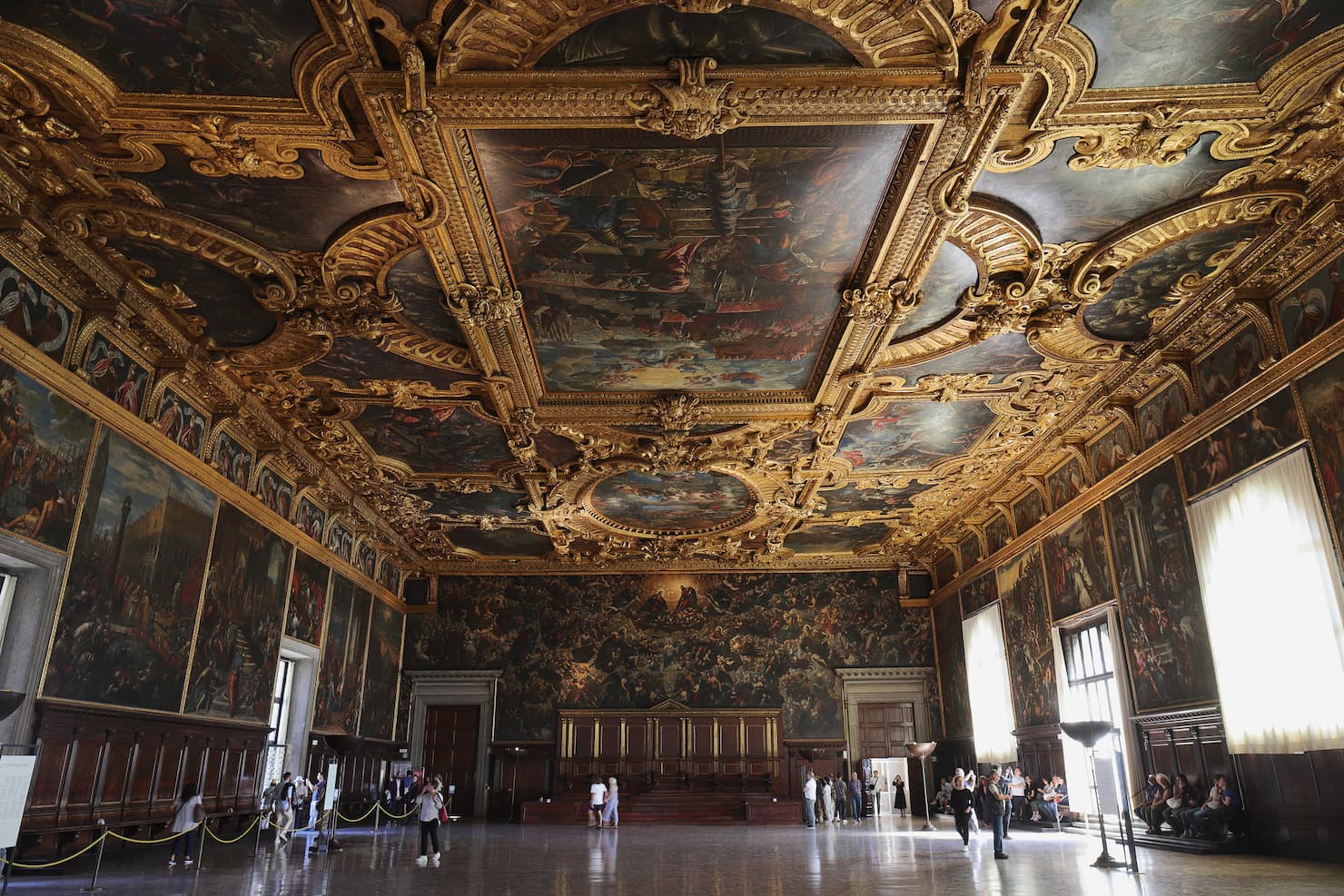
The hall is enormous in size, 53 meters long by 25 meters wide, could hold more than 2,000 people, and occupies almost the entire wing of the palace facing the basin of St. Mark’s.
The wooden ceiling is completely covered with gold and painted canvases, its structure is composed of a system of beams and trusses that allow the heavy ceiling to hold without the aid of columns.
The invention of this particular carved ceiling is due to Cristoforo Sorte, who thus made the room look like a huge open space, increasing the surface available to accommodate the celebration of the myth of Venice, depicted in the center of the roof.
To imagine what the hall must have looked like in the 1600s, I suggest you look at Joseph Heinz The Younger‘s 17th-century painting.
The work shows a meeting of the kind that was held every Sunday afternoon, to the ringing of the bell of St. Mark’s. The patricians of the city, dressed in black, would gather and vote on measures with their “balotte”. In the center sat the doge and above him the painting of Paradise.
Hall of the Great Council: paintings
Paolo Veronese, Tintoretto, Jacopo Palma il Giovane, Francesco Bassano, Andrea Vicentino, Carlo and Gabriele Caliari, Paolo Fiammingo, Federico Zuccari, Giulio dal Moro, Jean Le Clerc, Antonio Aliense, and Gerolamo Gambarato took part in the decoration of the hall following the fire that devastated its interior in 1577.
These artists made this environment a veritable compendium of late sixteenth-century Venetian painting.
The preparatory drawings were made by the Florentine monk Gerolamo de Bardi, assisted by two patricians who were experts in painting and history. The Venetian historian Francesco Sansovino also participated in the iconographic project. The program was also published in the form of a descriptive text in 1587.
On the walls are large canvases, the most used representational mode in Venice, given the damp conditions that did not allow the fresco to be preserved.
The canvases depict episodes from Venetian history such as “The Fourth Crusade” of 1202, placed on the side facing the basin, and “The Peace of Venice,” the underlying theme being the city’s relations with the papacy and the Holy Roman Empire.

The canvases that adorn the roof of the hall depict deeds and virtues of valiant Venetian citizens, while in the center is an allegorical glorification of the Republic by Veronese, the “Triumph of Venice, Crowned by Victory,” placed on the wall of the tribunal.

The work depicts Venice crowned and surrounded by Honor, Peace, and Happiness in the presence of all Venetian society, from the nobility down to the people, guarded by mounted guards. Venice is thus depicted as the protector of the arts of the weak and of peace and inspired by the greatest virtues. The perspective of the mighty architecture represented is conceived as a dynamic and luminous theatrical scene.
Toward the courtyard are placed canvases of twelve episodes concerning the “Vicissitudes of Alexander III and Frederick Barbarossa,” these paintings represent a skillful manipulation of history for propaganda purposes to legitimize certain attributes of doge dignity.
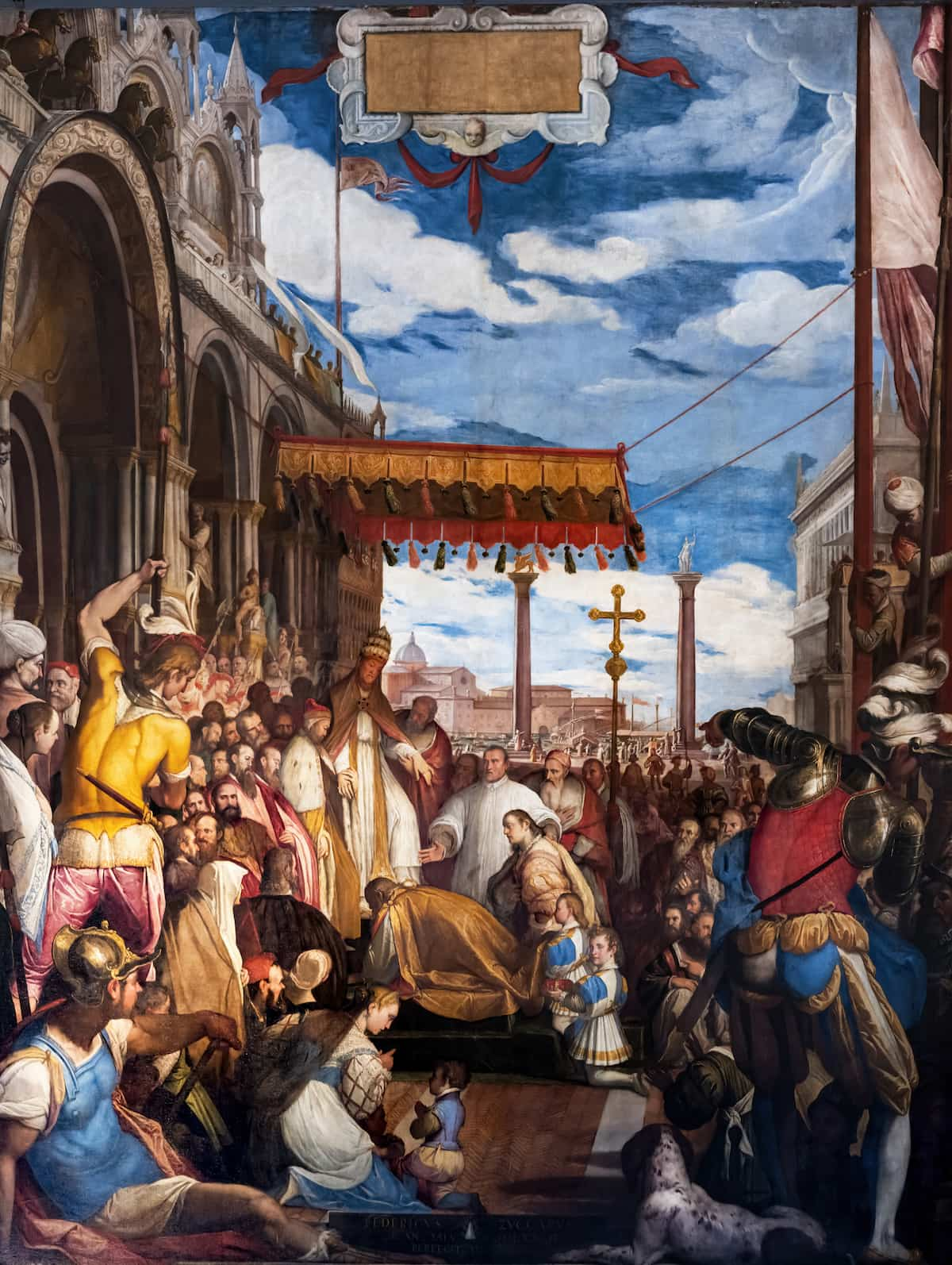
Beneath the ceiling is a frieze by Tintoretto bearing portraits of the first seventy-six doges of Venice (from the year 804 to 1556), each doge holding a scroll on which are depicted the most significant works of his dogate.
You will notice that one of the doges is depicted with a black drape: this is Marino Faliero, the doge who in 1355 attempted a coup d’état and was sentenced to be beheaded; in fact, the drape bears the inscription “HIC EST LOCUS MARINI FALETRO DECAPITATI PRO CRIMINUS ” (this is the place of Marino Falier who was beheaded for the crimes he committed).

At the end of the room is the colossal painting of “The Paradise” made between 1588 and 1592 by Jacopo Tintoretto. The canvas is composed of several stitched canvases and is populated by a multitude of figures of saints and angels, the vision, despite representing paradise, is unexpectedly chaotic and crowded, almost gloomy.
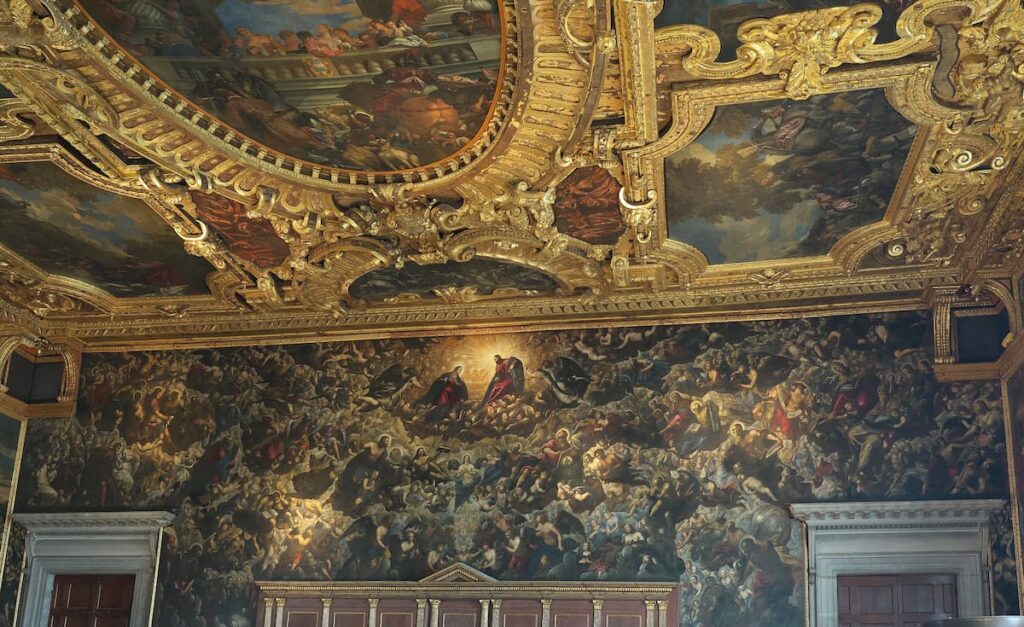
This representational mode is characteristic of the art of Tintoretto, who liked to convey a sense of pathos and drama in his works by contrasting light and dark colors.
The painting has Jesus and Mary as the central protagonists; a light below them descends; it is the holy spirit that falls exactly on the tympanum of the throne on which the doge sat.
The theme is not only religious but also an allegory of Good Government, the light is the divine essence that enters the figure of the doge, invested with a heavenly mission, enabling him to always make the right decision.
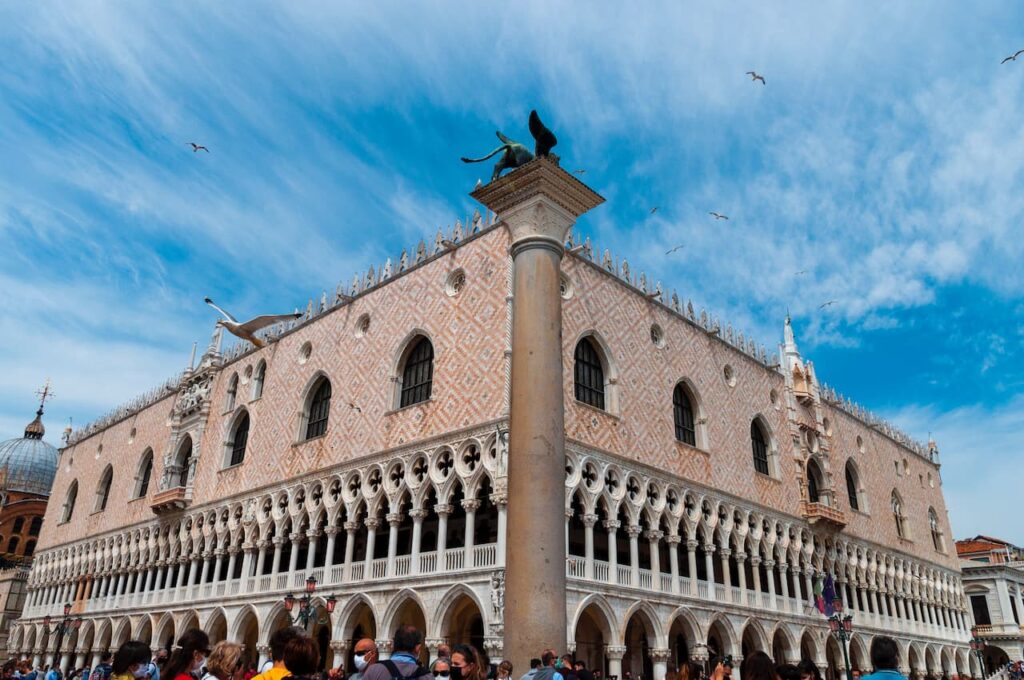
Doge’s Palace Venice tickets: quick access
Buy online. Choose your preferred time. Visit Venice’s Doge’s Palace, Hall of Great Council, prisons and more.
You can cancel for free until the day before your visit.
Frequently Asked Questions
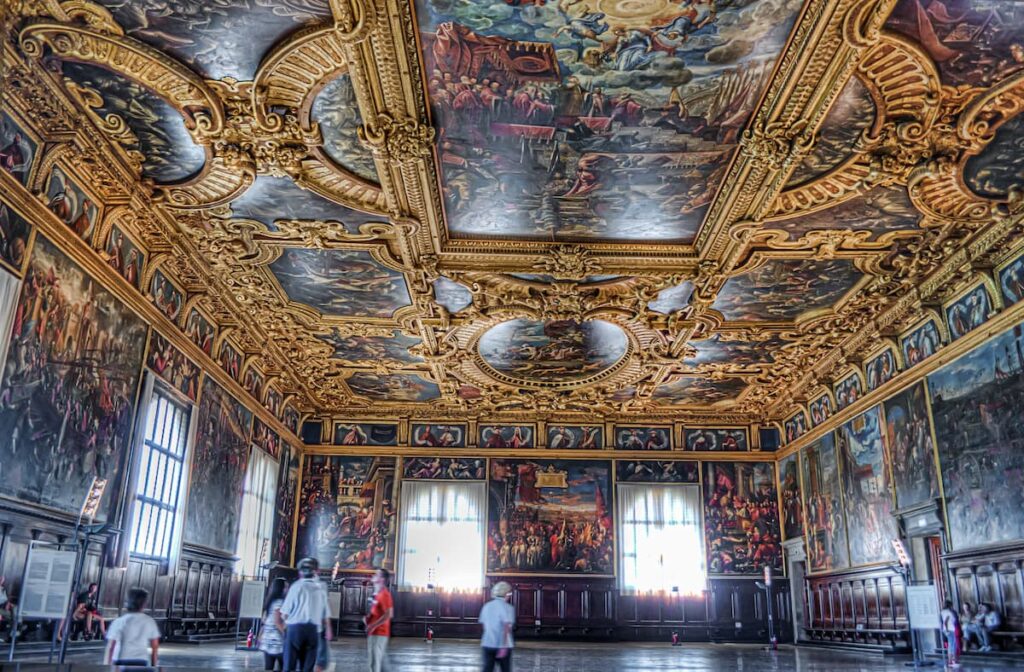
Where is the hall of the Great Council located?
The Hall of the Great Council is located in the Doge’s Palace of Venice, in the wing that faces St. Mark’s Basin. The hall is part of the tour of the palace’s interior.
How were the pews and seating arranged inside the Great Council Chamber?
the benches were arranged in parallel rows, in the direction of the length of the hall, each row had benches on either side, so on the right and left.
The patricians sat on the rows in the center and against the wall, while the doge was seated in the center, under the painting of paradise, flanked by the councillors, the three heads of the Council of Ten, the Quarantia Criminale, the avogadors, and the censors.
For more information, you can take a look at Francesco Guardi’s painting (The Doge of Venice Thanks the Great Council).
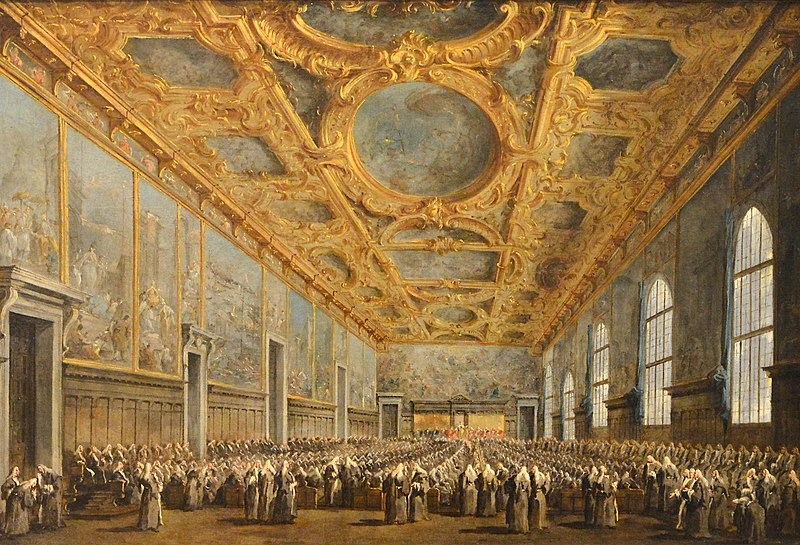
How big is the hall of the Great Council?
The Great Council Chamber of the Doge’s Palace in Venice is 52.70 meters long, 24.66 meters wide and 11.50 meters high, for a total of 1,250 square meters of floor space. These incredible dimensions make it rightfully the largest room in the Doge’s Palace in Venice.
What was the Great Council Lockout?
In the year 1297, under Doge Pietro Gardenigo, a reform known as the “Serrata del Maggior Consiglio” (Great Council Lockout) was passed, by which the office of member of the Major Council, the highest institution of the Republic responsible for electing the doge, was made hereditary. The reform precluded the working classes from entering government and also set the number of senators at 586 members, later increased to 1212 in 1340.
How was the government organized in the Republic of Venice?
The Venetian republican system provided for the entire aristocratic class to participate in the administration of power; members of the government were appointed through a cumbersome system of voting and contumacies.
The families of the lagoon patriciate were divided into four classes: the first class was that of the so-called “old houses” and was the oldest, followed by the “new houses” that appeared after the year 800, the “case nuovissime” inserted from 1380, and finally the houses that bought noble titles after the Candia and Morea wars between the late 17th and early 18th centuries.
The most important body was the Great Council, comparable to our parliament, which was responsible for the legislative function. Meetings were held there every Sunday morning in the hall of the same name, always attended by the doge. The members were numerous, 400 in the first centuries of the Duchy until 1200 with the lockout of the Great Council.
Following this reform, the office of member of the assembly became hereditary, one became a member from the age of twenty-five (or twenty in the case of being drawn by lot on St. Barnabas Day).
The mandatory requirements were to be born into a patrician family by legitimate marriage and not to have already been initiated into an ecclesiastical career.
The Great Council governed the city through a series of commissions and magistracies, the main ones being the Senate, the Council of Ten, the Savi di Terraferma e di Mare, and the Provveditori.
How were members of the Great Council elected?
Elections took place inside the Scrutiny Hall of the Doge’s Palace and were very laborious.
Once the incumbent doge had died, the Council would meet and instruct its youngest councilor to summon a child between the ages of eight and ten. The child’s task was to draw by lot from an urn the names of thirty councilors (who were not to be related to the person concerned).
In the meantime, metal balls, known as “balotte” (a term from which the word ballot is derived), were placed in the urn, as many as the number of council members under the age of thirty.
Inside thirty of them was inserted a cartouche with the word “lector.” The thirty ballots were made of gold, while the remaining were made of silver.
When the thirty councilors were drawn from the boy, called “ballottino,” a new draw was thus made and nine persons were identified whose task it was to choose another forty, then by a further draw the nominees were reduced to twelve.
The twelve thus voted for twenty-five patricians, brought down to nine by drawing lots.
The nine members would then nominate forty-five, from which eleven would be drawn.
The eleven would then draw by lot the forty-one who were to be elected doge.
The final election took place after the mass in St. Mark’s Basilica, after which the appointees would gather in the special hall and write the names on secret ballots, swearing to vote according to conscience.
Once the doge was elected the ballot was given the position of his personal notary.
This really complicated system, reminiscent of a lottery, avoided the danger of cheating.
What paintings are contained in the Hall of the Great Council?
The room holds numerous paintings that make it a wonderful compendium of what was Venetian painting in the late 16th century, among them are:
- Coronation of the Virgin; Guariento
- Triumph of Venice; Paolo Veronese
- Doge Nicolò da Ponte, in the presence of Venice, receiving the homage of the ambassadors of the subject cities; Jacopo Tintoretto
- The Paradise; Jacopo and Domenico Tintoretto
- Venice crowned by Victory welcomes the subject provinces; Jacopo da Palma il Giovane
- Portrait of Doge Andrea Dandolo; Tintoretto
- The Taking of Smyrna; Paolo Veronese
- The defense of Scrutari; Paolo Veronese
- The battle of Casalmaggiore; Francesco Bassano
- The battle of Polesella; Francesco Bassano
- The battle of Riva; Tintoretto workshop
- The battle of Argenta; Tintoretto workshop
- The defense of Brescia; Tintoretto workshop
- The battle of Gallipoli; Tintoretto workshop
- The battle of Maclodio; Francesco Bassano
- The battle of Cadore; Francesco Bassano
- The victory of Cremona; Jacopo Palma
- Andrea Gritti reconquers Padua; Jacopo Palma
- Pope Alexander III delivers the sword to Doge Sebastiano Ziani; Francesco Bassano
- The conquest of Zara; Andrea Vicentino
- The taking of Constantinople; Domenico Tintoretto
- The victory over the Genoese at Chioggia; Carlo and Gabriele Caliari
Conclusions
Here we are at the end of this walk inside the Great Council Chamber of Venice, where I have told you about its history, architecture, and the most famous works housed inside.
If you have any further questions do not hesitate to write to me, while if you want to admire with your own eyes this extraordinary hall firsthand, book a visit inside the Doge’s Palace in Venice.
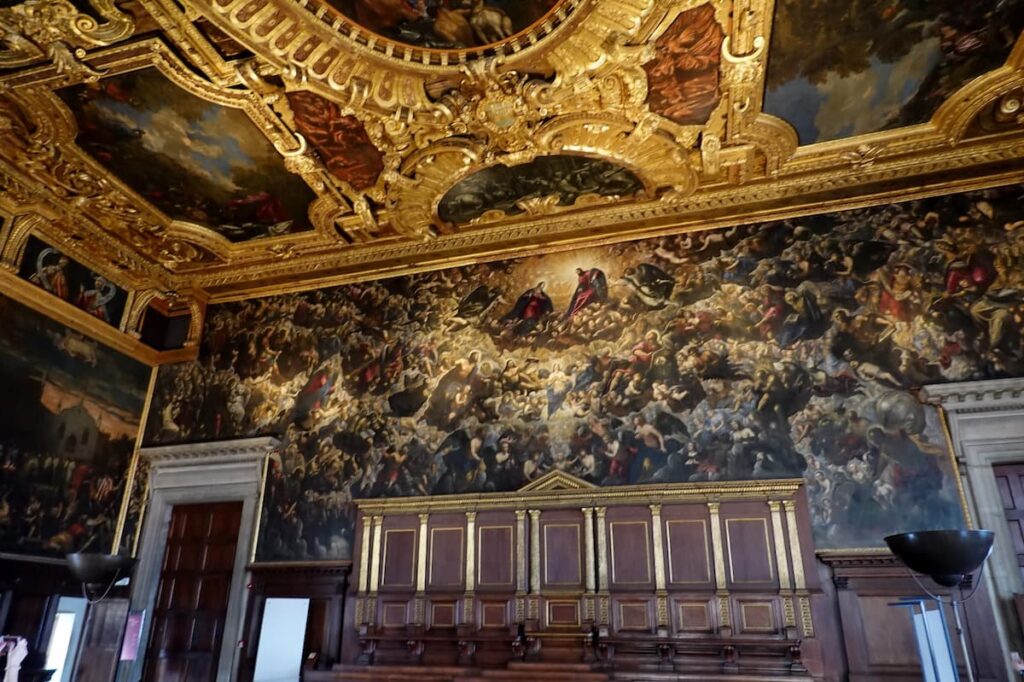
Doge’s Palace Venice tickets: quick access
Buy online. Choose your preferred time. Visit Venice’s Doge’s Palace, Hall of Great Council, prisons and more.
You can cancel for free until the day before your visit.
Photo credits:
- Sala del Maggior Consiglio: Photo by Michael Kemper via Flickr
- Pace di Venezia: Photo via Wikimedia
- Marino Faliero e il drappo nero: Photo by Falcodigiada via Wikimedia
- Barbarossa bacia il piede al Papa: Photo by Archaeodontosaurus via Wikimedia
- Il Paradiso di Tintoretto: Photo by CdeHaan via Flickr
- Salone del Maggior Consiglio: Photo by David Abrantes via Flickr
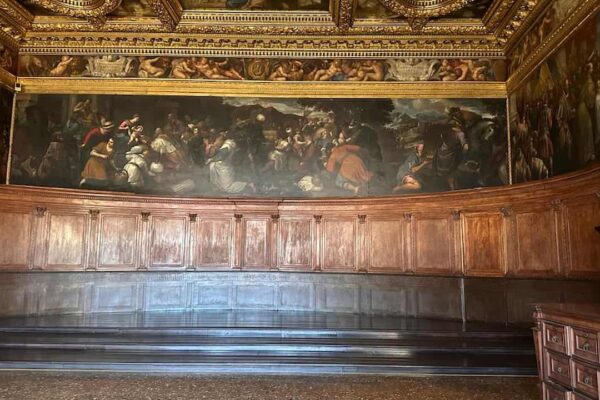
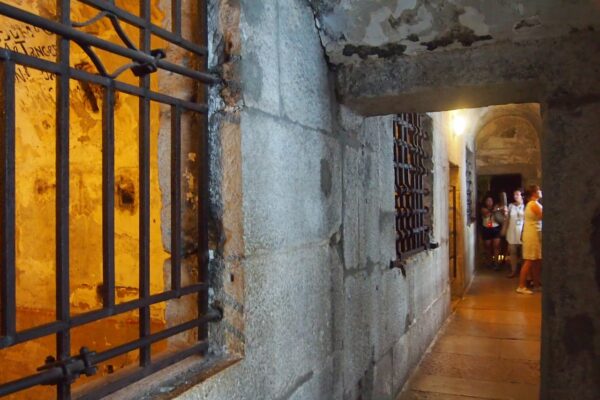
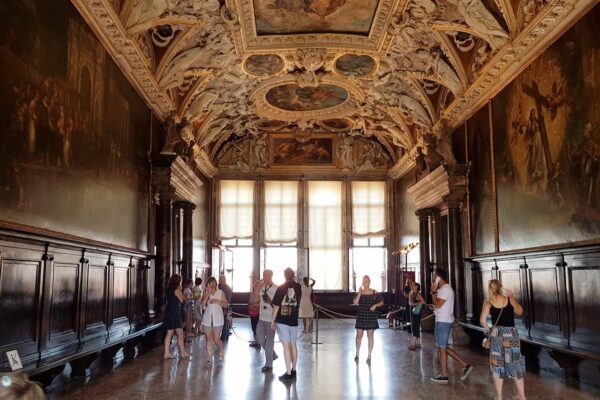
5 Comments. Leave new
pls can zou explaain to me these double row of banches.. why was the sitting so arranged.. also who was sitting against the wall
Hello Desta, the benches were arranged in parallel rows, in the direction of the length of the hall, each row had benches on either side, so on the right and left.
The patricians sat on the rows in the center and against the wall, while the doge was seated in the center, under the painting of paradise, flanked by the councillors, the three heads of the Council of Ten, the Quarantia Criminale, the avogadors, and the censors.
For more information, I invite you to take a look at Francesco Guardi’s painting (The Doge of Venice Thanks the Great Council).
Best regards,
Andrea
Hello!
I was wondering if you know of any depictions of the hall that might give an idea as to what it might’ve looked like around 1494, or at least pre-1577. I know early depictions of this sort of thing are scarce, but I figured I might still try.
My main curiosity is with the Major Council Hall of the nearby Republic of Ragusa/Dubrovnik, which burned down in the early 1800s. A Milanese visitor in 1494 described it like this: “inside [the Rector’s Palace], amongst other things, there is a beautiful hall, built in the likeness of the hall at Venice, where the Venetian gentlemen hold their Great Council, and with similar benches. It is true that the seats are not gilded, as they are at Venice, for seating the Great Council; the ceiling, however, is adorned with gold and fine blue.” Seeing as there are no surviving depictions (as far as I know, and I’ve inquired with experts) of the Ragusan hall, I thought I might try to imagine it using the Venetian precedent.
I’ve also always loved the ominous vagueness of “Decapitati pro Criminibus!”
Regards,
Nathan
Hello Nathan, there are no certain records (also because there were numerous fires, and we don’t know for sure which paintings survived).
What we can tell you, however, is that at the Correr Museum there is an anonymous representation of the room before the 1577 fire.
You can tell because in the background is the Guariento fresco.
Best regards,
Andrea
Thank you! That helps!
Nathan